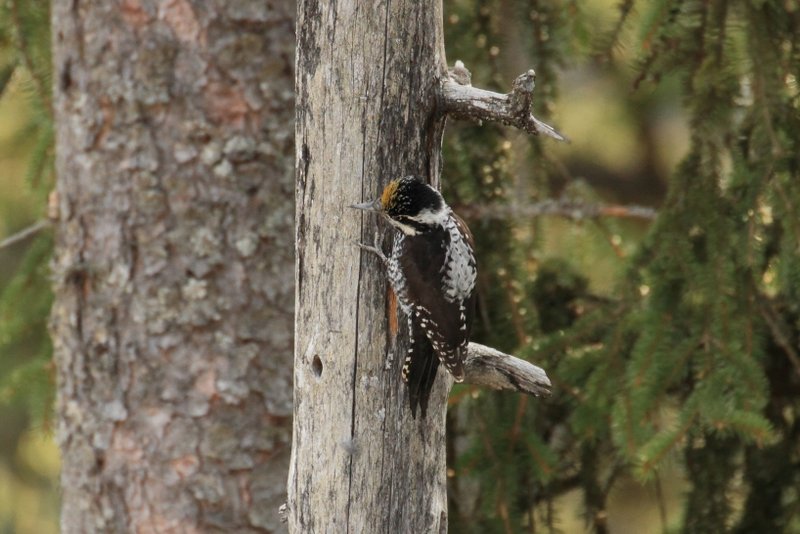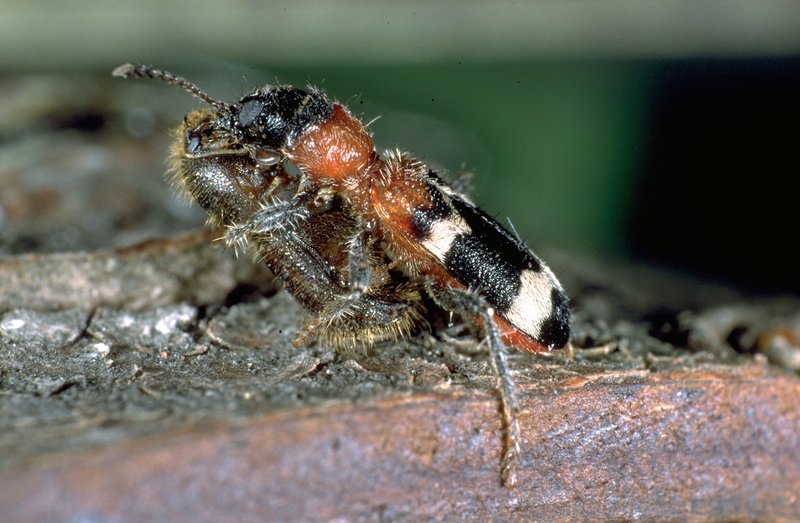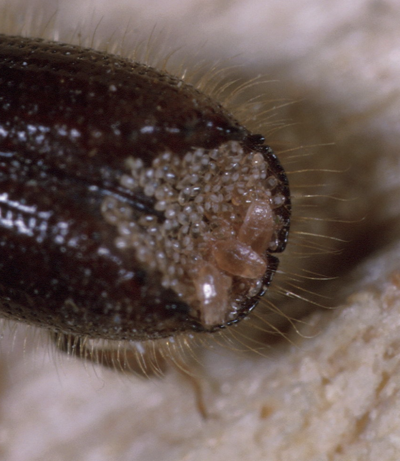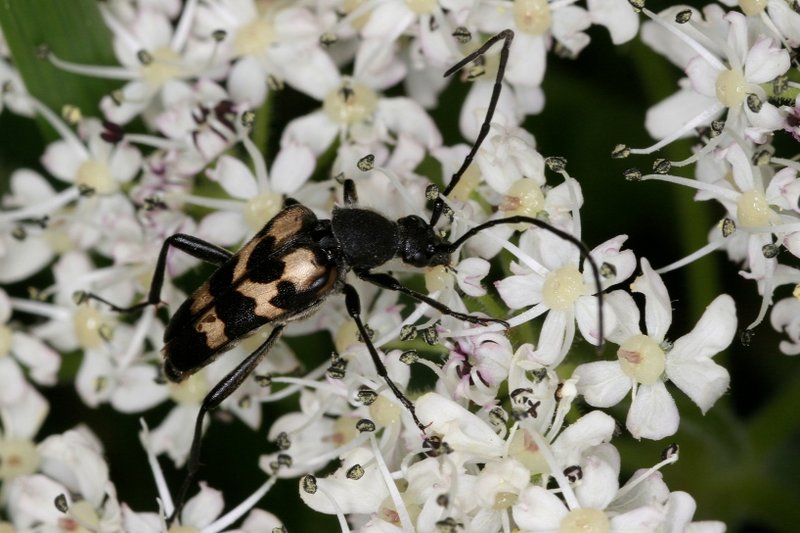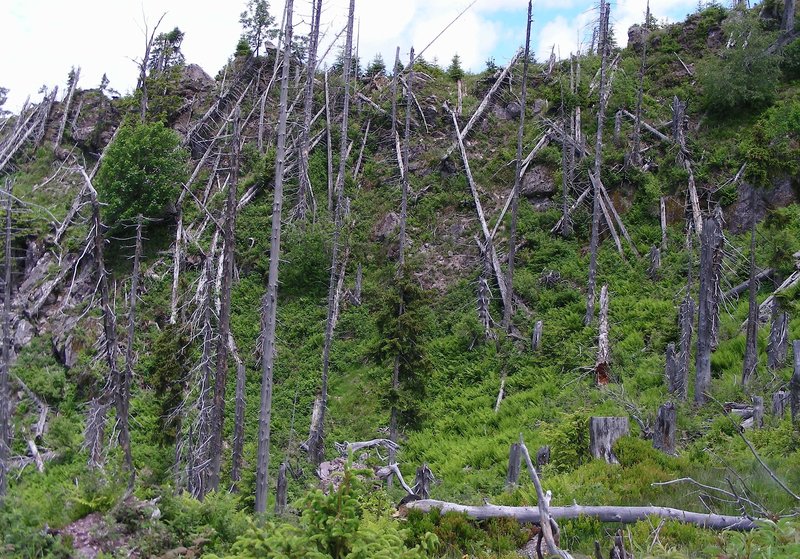
Fig. 1. Disturbances caused by the European spruce bark beetle can have an ecologically valuable effect. After a bark beetle outbreak, a new habitat emerges, with herbaceous plants, pioneer tree species and abundant deadwood. This habitat is utilised by countless organisms, until a closed forest re-develops with other inhabitants. Photo: Doris Hölling
In years of mass propagation, some bark beetle species can indeed have a severe negative impact on the provision of important forest services expected by humans, such as the production of timber, protection from natural hazards, or recreation. We tend to forget that they also perform important functions in the ecosystem.
Pioneers in wood decomposition
Bark beetles make a key contribution towards the decomposition of wood. Certain pioneer bark beetle species are for example the first insects to be able to penetrate the still intact bark of newly dead trees to establish their breeding systems. The bark of coniferous trees in particular initially still contains various toxic resins and tannins that impede rapid colonisation by wood-degrading fungi.
- The entry and exit boreholes drilled by the beetles do however create entry points for these fungal spores, so that the recycling of the nutrients stored in the tree can begin, facilitating the growth of other herbaceous and woody plants.
- The bore dust and faeces of the beetles and larvae are also quickly colonised and broken down by micro-organisms and fungi.
- The feeding activity of the larvae and young beetles also loosens the bark from the sapwood. This opens up the body of the wood for other insects and fungi.
- Some bark beetles, including the European spruce bark beetle - the bark beetle species with the greatest economic impact - often also introduce a fungus that facilitates their colonisation of the wood, interrupts the transport of water in the wood, and breaks down cell contents. Ambrosia beetles do something similar, actively introducing a fungus into the wood as food for their brood.
Like bark beetles, wood wasps are typically also among the first to colonise and begin the decomposition of newly dead trees. They likewise introduce a fungus that predigests the wood, allowing the larvae to break it down later.
Food for other organisms
Due to their hidden lifestyle under the bark or even in the wood, bark beetles are well protected against generalist predators and parasitic insects. They nevertheless serve as food for a variety of different organisms.
Various bird species will seize the opportunity to grab flying beetles or beetles running around on the surface of the bark. These do however tend to be lucky catches.
Woodpeckers, on the other hand, are not only able to use their beaks to catch bark beetles on the surface of the bark, but are the only bird species also able to pick them out of the bark or wood. Individual bark beetle larvae are not a rich source of food as such, but as they are present in large numbers and can be extracted from the bark with little effort, they are still worthwhile prey. The utilisation of bark beetles as a source of food is seasonal, depending on the species of woodpecker. Other food sources such as caterpillars or ants are scarce or difficult to access in winter, so that bark beetles can account for up to 99 per cent of the diet of some woodpecker species. The three-toed woodpecker is even a bark beetle specialist and thus an important natural adversary.
As well as woodpeckers, there are a large number of insects that feed as predators or parasites on bark beetles, and that are therefore dependent on them for food. These include various predatory beetles and flies, as well as parasitoid ichneumon wasps.
Transport
Bark beetles can also transport other organisms. One example is fungus spores, which are carried by the migrating beetles to the next tree, where they can multiply again.
Various mite species also use bark beetles as a means of transport (=vectors). These are mite species that occur in short-lived habitats and feed on various waste products and fungi in the bark beetle galleries. The flightless mites are dependent on such vectors for their dispersion. They attach themselves to or under the wings, or to the chests of bark beetles ready to fly, and are thus able to reach new habitats. At the new location, the mites then enter the beetles’ breeding systems through their boreholes. In the case of the European spruce bark beetle, it has been found that 30% of the beetles carry mites. These do not harm the vector, as they are at an inactive migratory nymph stage. On the contrary, the beetles also transport predatory mites that feed on nematodes that live on bark beetle larvae. Both thus benefit - the mites from being transported by the beetles, and the beetles from the reduction of pathogenic nematodes.
Increasing forest vitality
Every healthy forest that develops without human influence also contains old, weakened or diseased trees. Such trees are often susceptible to being colonised and ultimately killed by certain bark beetles such as the European spruce bark beetle (see Fig.3->4). The loss of these individual trees creates space for new young trees, brings light into the stand, creates deadwood, and thus promotes the overall vitality of the forest.
Habitat designer
Some bark beetle species such as the European spruce bark beetle can strongly influence and shape their habitats, so much so that they are known as “ecosystem engineers”. The climatic conditions in a bark beetle-infested area after the death of the spruce trees are very different to those prevailing when the stand was still intact. The resulting deadwood is an essential resource for a large number of organisms. Fungi, lichens and insects - initially mainly beetles - develop in or on the newly created substrate.
- Woodpeckers then feed on the larvae developing in the wood, and build their nest cavities in the dead but still standing trees. They can also detach entire plates of bark from the trunk, complete with young beetles. These fall, allowing the young beetles to be picked off by other birds.
- Old woodpecker cavities then become breeding and roosting sites for other cavity-nesting birds, small mammals and bats.
- Amphibians find suitable hibernation sites under fallen dead trees, and reptiles can sunbathe on trunks and stumps protruding from the ground vegetation.
- The wood decomposes over decades, being used as a habitat by all sorts of species of beetles, hymenoptera, flies and mosquitoes, depending on the degree of decomposition.
- And finally, numerous different species of fungi break down the components of the wood that are indigestible for other species, such as cellulose and lignin.
In Switzerland, almost 5000 organisms (=¼ of all species living in the forest) are such deadwood users. Many of them feature on the Red Lists of endangered species.
A study in the Bavarian Forest National Park has shown that the stand edges opened up as a result of bark beetle outbreaks are hotspots of insect biodiversity. Deadwood beetles in particular were more numerous, and there was significantly greater diversity of wild bees and wasps in former infestation hotspots than in the still intact forest stands.
If spruce stands die off over extensive areas after a mass propagation of bark beetles, entire landscapes may change. Where the forest once consisted of a dense growing stock of spruce trees, an open, sunny habitat emerges for a few years or decades (see Fig. 1.). A new forest development sets in naturally, offering new habitats for a huge number of different plant and animal species. Succession begins with the vigorous growth of all sorts of herbaceous plants, shrubs and bushes, such as wild strawberry, willowherb, ferns, raspberry or bramble, followed by pioneer woody plants such as willow, birch and rowan, until the final tree species ultimately dominate again. Depending on the climatic conditions, this process can take several decades. During this period, the former beetle outbreak area is completely different from the surrounding forest. It not only provides food for herbivorous and flower-frequenting insects, but a habitat for a rich diversity of small mammals and birds. Such areas are often also attractive grazing areas for game.
Changed site conditions
The hydrological and chemical properties of the soil change in beetle outbreak areas. Water runoff from the soil into the groundwater and streams increases, as does the nitrate content of the groundwater temporarily. The dramatic short-term increase in the shedding of needles, the increased availability of sunlight, and the changed soil climate increase nitrogen mineralisation. This is also reflected in the longer term in a higher nitrogen content in the new needles of the surviving trees.
Extensive bark beetle infestations on a regional scale mean that the affected forests bind less carbon. They may change temporarily from being a carbon sink to being a source of carbon. The surviving trees and the emergent young growth will however have compensated for this after one to two decades.
Bark beetles thus not only have an economic, usually negative impact for us humans, but also play an essential role in natural forest dynamics, in the food web, in the turnover of nutrients, and in the creation of new habitats.
Translation: Tessa Feller

